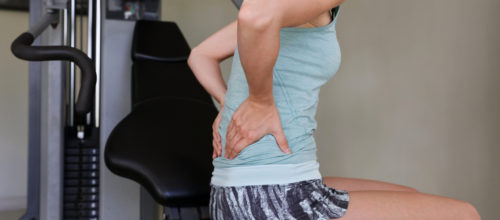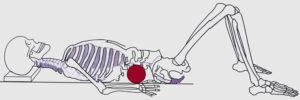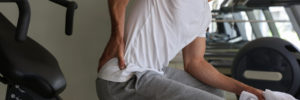
30 DAYS OF LOW BACK PAIN: DAYS 1-10
I’m willing to bet that if you’re reading this blog post — you have a bad back.
I’m also willing to bet, given your low back scenario, and given this blog is dedicated towards strength & conditioning, you’re interested in:
- Keeping your low back healthy.
- Making your low back resilient to injury.
- Building a bulletproof spine.
Day 1 – Chest Press Set-up
When I went through my low back issues, setting-up for the dumbbell chest press was difficult. Holding 2 dumbbells and moving from a seated position to a supine position was not comfortable. One solution I found to this problem was to modify the dumbbell chest press and switch to a barbell chest press.
The barbell chest press involves unracking a bar from a supine position, instead of having to move weight from a seated to a supine position.
Much easier to manage.
https://www.instagram.com/p/B2Z9h6rHmMH/
Day 2 – Bench Press Alternative for Extension-based Back Pain
While the bench press is a power-lift – not everyone is a powerlifter. And not everyone needs to lift like a powerlifter.
During my time with the Toronto Raptors —one tip I learned from physical therapist Alex McKechnie is that if you elevate the feet during a bench press — you can encourage a posterior-pelvic tilt. Encouraging posterior-pelvic tilt limits the chance a person may fall into lumbar extension.
A simple and quick hack.
https://www.instagram.com/p/B2cgfL2HiGj/
Day 3 – Barbell Overhead Press & Low Back Pain
Thanks to Eric Cressey’s work, I’ve learned over the years that a lot of people aren’t suitable for barbell overhead pressing. People lack anterior-core control and tend to be stiff/short through their upper-back, which limits their ability to get overhead safely.
Often you’ll see people compensate with lumbar extension to get a barbell directly overhead.
Not an ideal position to move into under load.
https://www.instagram.com/p/B2eyzw4nzTP/
Day 4 – Hip Mobility & Low Back Pain
If you lack hip mobility – your low back may compensate to make up for the lack of motion at the hips.
What’s the result?
The low back does more work.
A good example is seen in professional golfers with a history of low back pain. Vad, Bhat, Basrai, Gebeh, Aspergren & Andrews (2004) showed a lack of hip internal rotation on the lead hip correlated with the golfers who had a history of low back problems. Golfers who didn’t lack hip internal rotation were the ones who didn’t present with a history of low back problems. A lack of hip internal rotation may cause the passive restraints of the low back (discs, ligaments) to take more stress.
The takeaway.
Getting the hips to move better helps spare the low back.
https://www.instagram.com/p/B2hdnYqniSl/
Day 5 – A Simple Tip to Spare the Low Back When You Cough or Sneeze
Dr. Stuart’s McGill’s book “Back Mechanic” has a treasure trove of low back pain tips.
And one of them involves coughing and sneezing.
Tilting your neck upwards and directing your cough or sneeze in an upward manner helps spare the low back.
A simple tip that almost everyone can benefit from.
https://www.instagram.com/p/B2j3pMXHbKC/
Day 6 – The Barbell Bent-Over Row & Low Back Pain
After sustaining my back injury – the barbell bent-over row was an exercise I distanced myself from.
I did not like the feeling of being in a bent-over position and having to pull heavyweight.
I feel this exercise puts an unnecessary amount of stress on the low back. And there are better exercises out there that can produce a similar training effect without having to tax the low back.
Some better alternatives include TRX row, chest-supported row and a standing cable row.
https://www.instagram.com/p/B2mq0OVF3bU/
Day 7 – Why You Should Never Foam Roll The Low Back
Foam rolling the low back is not a good idea.
Applying full bodyweight shear stress to the lumbar spine could trigger a host of problems that involve:
- Create instability and perhaps lead to painful micromovements.
- Place unnecessary stress on the facet joints if you roll along the roller in extension.
- Put pressure on an irritated nerve root.
If you have low back issues or feel a slight discomfort in the low back – please don’t foam roll it.
Instead, go see a skilled manual therapist who can perhaps do specific trigger point release or an adjustment.
https://www.instagram.com/p/B2o_86sHDJL/
Day 8 – SI Joint Pain & Split Squats
Too many split-squats, lunges, step-ups or any single-leg exercise that involves one side of the pelvis mutated forward, and the other side backwards could lead to an SI-Joint problem.
According to Dr. McGill, when you perform an excessive number of 1-leg exercises, and you factor in load – you can perhaps create hypermobility at the SI joint and cause a painful micromovement.
I would suggest you be very considerate about how you program exercises like lunges, split-squats or step-ups in one’s program.
https://www.instagram.com/p/B2rq6_KnLkM/
Day 9 – Why You’re at a Greater Risk of Developing a Low Back Injury in the Early Morning
In the early morning, the discs are hyper-hydrated. The minimal compressive force we sustain while laying down during sleep causes our disc to absorb fluid.
The more fluid in the discs explains why we are taller in the morning.
The added hydration creates more tension in the disc. And the added height places a greater stretch on the posterior ligaments of the spine.
As a result, the low back is at a greater risk of injury in the early morning.
And to put into perspective. The bending stress is about 3x/ greater on the lumbar spinal discs in the early morning compared to the afternoon.
That means doing a sit-up in the early morning is about 3x/ more stressful on the spinal discs than if you performed it in the afternoon.
That’s a big deal!
https://www.instagram.com/p/B2uuJ0knbxP/
Day 10 – Why Pairing a Burpee with a Deadlift is a Bad Decision
Pairing a conditioning exercise such as a burpee with a deadlift is a bad decision.
A burpee is primarily performed for conditioning purposes.
And a deadlift is primarily performed for strength purposes.
If you induce full-body fatigue before performing one of the most technical lifts, the deadlift – you’re asking for trouble.
You’re better off pairing a deadlift with an exercise that compliments it and doesn’t induce the same fatigue.
I prefer exercises like a Birddog or mini-band side steps to pair with a deadlift.
https://www.instagram.com/p/B2xo-j4njt6/
Thumbnail Image Licensed from “ChesiireCat/canva.com”











